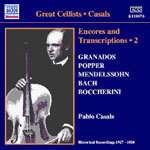
Encores and Transcriptions, Vol. 2 (Rec 1927-1930)
 $25.00
Out of Stock
$25.00
Out of Stock6+ weeks add to cart
VARIOUS
Encores and Transcriptions, Vol. 2 (Rec 1927-1930)
Pablo Casals (cello) with Nicolai Mednikoff, piano, Blas Net, piano, Otto Schulhoff, piano. London Symphony Orchestra / Pablo Casals, conductor
[ Naxos Great Cellists / CD ]
Release Date: Tuesday 1 February 2005
This item is currently out of stock. It may take 6 or more weeks to obtain from when you place your order as this is a specialist product.
"As before his novel and revolutionary vibrato usage comes under close scrutiny and that vocalized legato which he occasionally spun out with such daring elasticity demonstrate why he was the premier cellist of his generation...Collectors need not hesitate"
- Jonathan Woolf, www.musicweb.uk.net
For a protean musician such as Pablo Casals, the cello with its fairly narrow repertoire, even more restricted in his time than today, could never be a sole means of musical expression. When he returned to Barcelona from Paris in 1919, the local need for a decent symphony orchestra became obvious, chiming with his own desire to spread his wings a little. He was not the only Catalan to see the necessity to raise musical standards. The violinist and composer Joan Manén and the violinist and conductor Eduardo Toldra were also active, but Casals was the most famous, and in setting up the Orquestra Pau Casals, he was prepared to lay his personal wealth on the line - he would subsidise it for its first decade. The orchestra made its début on 13th October 1920 and in spite of his relatively slim conducting experience, Casals made a success of it. By 1927 he was well enough known as a conductor for HMV in London to risk recording him in this rôle. The 'bonus' track on this disc features him directing the London Symphony Orchestra in Beethoven's Coriolan Overture, in the ideal acoustic of Kingsway Hall. There are imprecisions, one right at the beginning, but the performance has all the hallmarks of the Casals conducting style, fervour, vigorous rhythm and full-blooded string tone. Much of the programme, however, is devoted to the short cello pieces that Casals set down in 1928-30, the last of his series for the Victor Talking Machine Company, a prolific session held over several days in Barcelona with the Catalan pianist Blai Net (known outside the region by the Castilian version of his first name, Blas), and three London-made tracks with the Viennese musician Otto Schulhof, his regular European accompanist.
The legendary Pau (or Pablo) Casals was born on 29th December 1876 in Vendrell, a little town in Catalonia where his father was organist and choirmaster. 'I owe nearly all my talent at music to the influence of my father', he wrote. 'As soon as I could walk he took me to all the services at the church, so that the Gregorian chant, the chorales and the organ voluntaries became part of myself and of my daily life.' Carlos Casals taught Pau to sing, play the piano and organ and even compose, and at six the boy had mastered the violin well enough to play a solo in public. Fascinated by a broom handle strung like a cello, used by an itinerant Catalan musician, he described it to his father, who built him a little cello using a gourd for a sound-box. 'On this home-made contrivance I learnt to play the many songs my father composed, and the popular songs which reached the village from the outside world.' At the age of eleven he heard a real cello, which confirmed it was the instrument for him. His father bought him a small one and gave him lessons; and soon he began studying at the Municipal School of Music in Barcelona. Cello playing had not greatly advanced since the days of Luigi Boccherini. The invention of the spike or endpin had freed the body of the instrument from being gripped between the knees, so that it resonated more freely, but some players were still operating in the old way, without a spike. Worst of all, the bowing arm was restricted. 'We were taught to play a with a stiff arm and obliged to keep a book under the armpit', recalled Casals. While playing in a café trio to pay for his keep, he was heard by the composer Albéniz. Soon he had an ensemble of seven at a grander café, and it was while he and his father were looking for music for this band to play that he found an edition of the Bach solo Suites. He met Sarasate and with Albéniz's help moved to Madrid, found a patron and became Queen Maria Cristina's favourite musician, studying at the Conservatory with Tomas Bretón and Jesus de Monasterio. He made his Madrid orchestral début with Lalo's Cello Concerto and in 1899 played it at the Crystal Palace in London and the Lamoureux Concerts in Paris. In 1901 he toured America and in 1905 he settled in Paris.
Tracks:
Cello Concerto in D major: Grave ed espressivo
Coriolan Overture, Op. 62
English Suite No. 6, BWV 811: Gavotte
Kinderszenen, Op. 15: Traumerei
L'estro armonico: Concerto Grosso in D minor, Op. 3, No. 11: Largo
Mazurka, Op. 11, No. 3
Orchestral Suite No. 3 in D major, BWV 1068: Air Requiebros
Schemelli Gesangbuch: Komm susser Tod
Serenata napoletana, Op. 24, No. 2
Six Minuets, WoO 10: Minuet No. 2 in G major • Sonata for Violin and Viola in C major: Minuet
Sonata No. 2 in A minor, BWV 1003: Andante
Sonata No. 6 in A major: Adagio
Sonata No. 6 in A major: Allegro
Song without Words No. 49 in D major, Op. 109
Songs My Mother Taught Me, Op. 55, No. 4: Gypsy Song Spanish Dance
Tonadilla
Tsar Sultan: Flight of the Bumblebee
Violin Sonata No. 10 in E major: Gavotte



